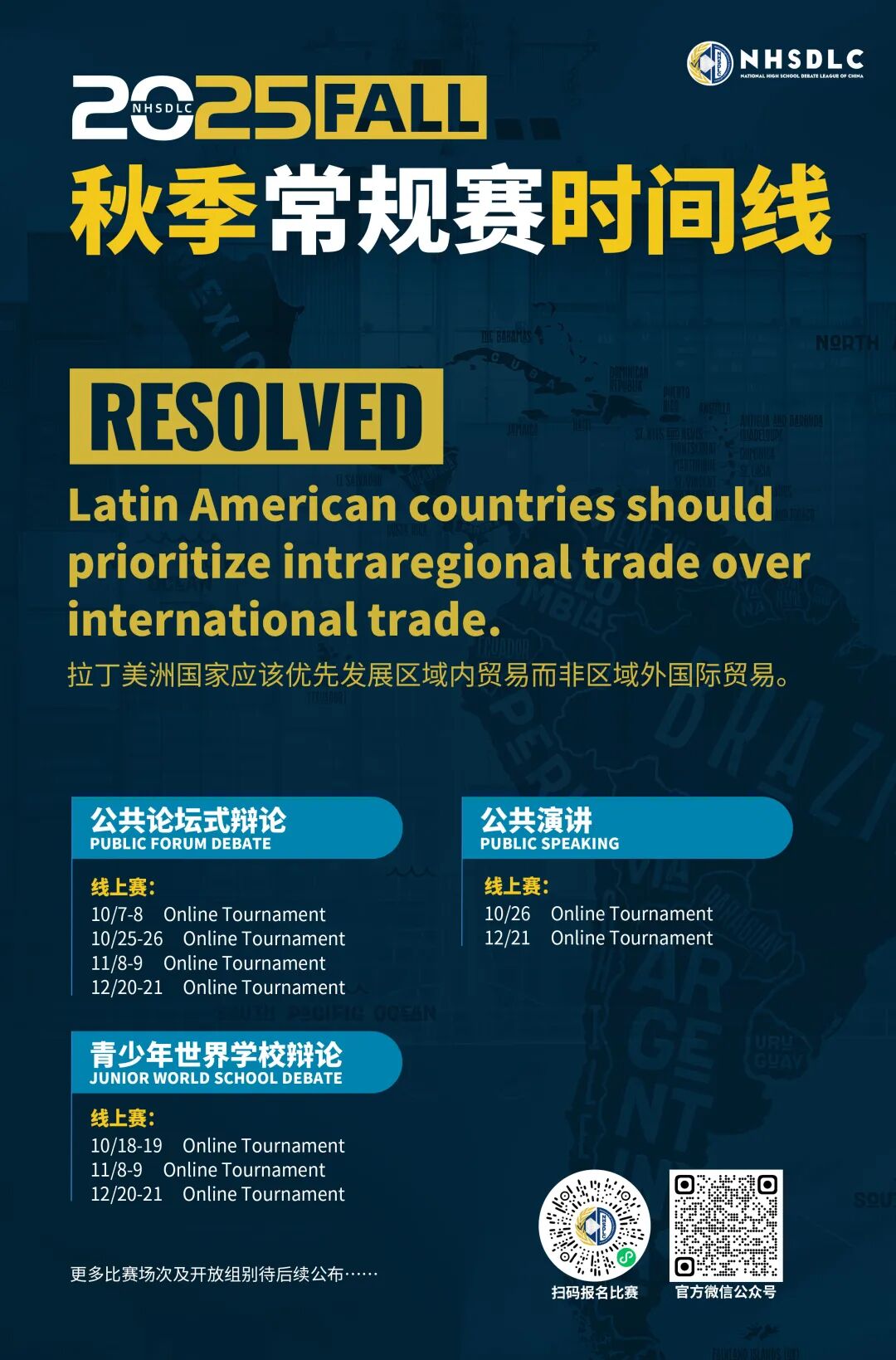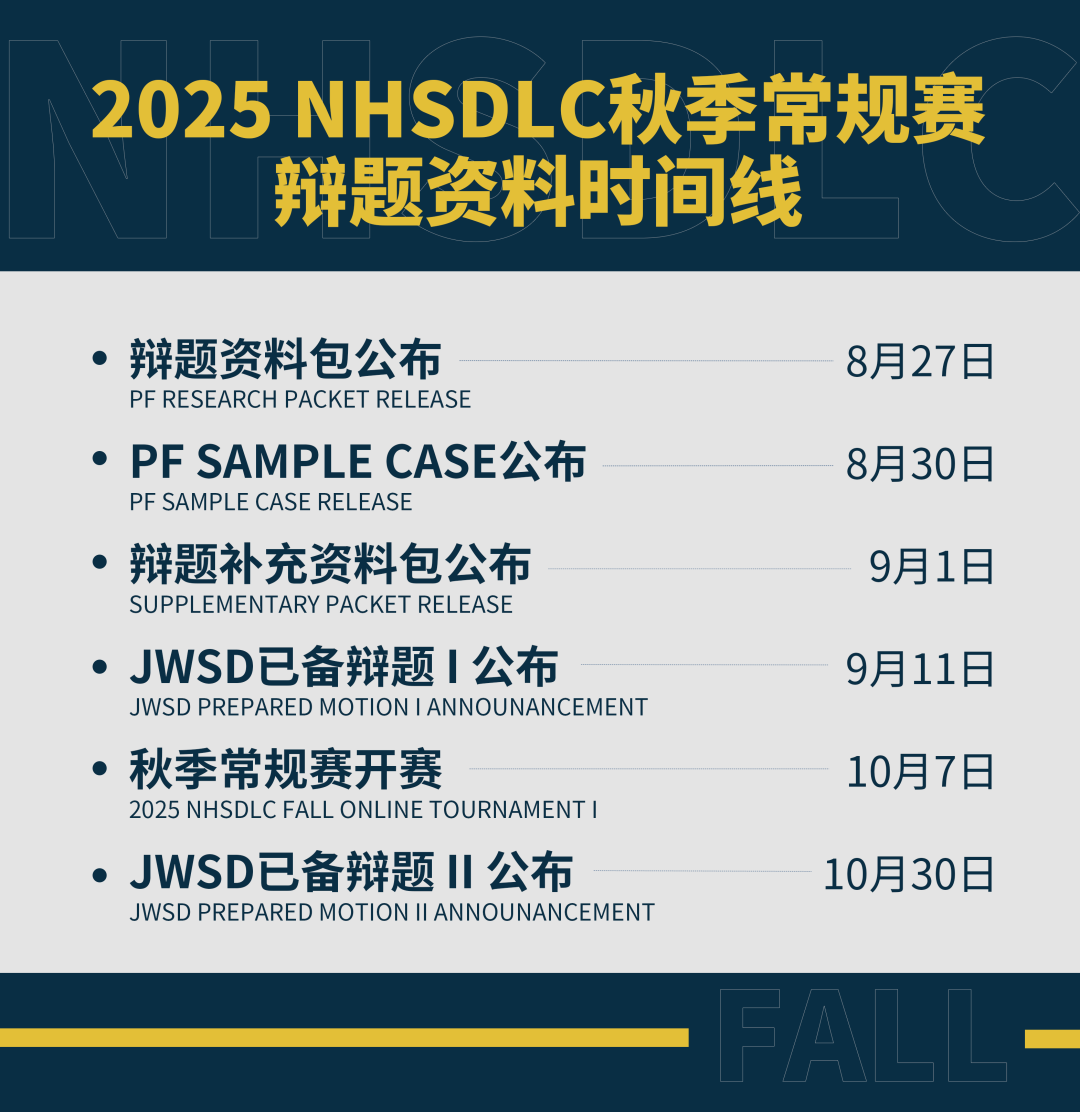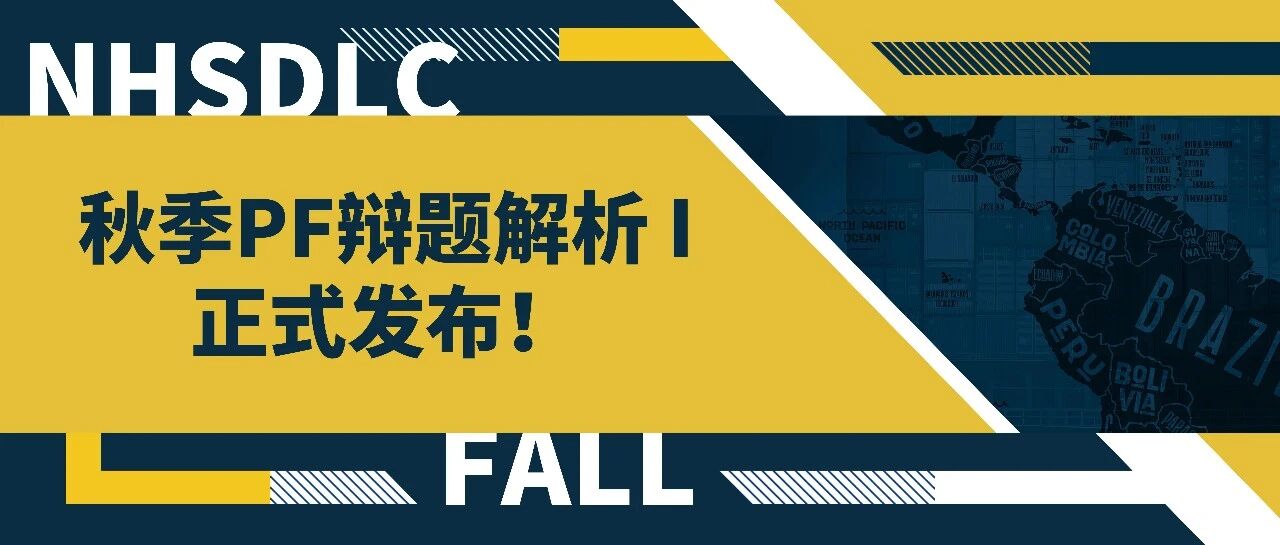今年秋季PF辩题聚焦经济领域
向各位辩手抛出了一个亟待解决的问题
发展区域内贸易VS开拓国际市场
拉丁美洲该何去何从?
这一辩题给正反双方都留足了可辩空间
但在开始辩论之前
千万不要忘记首先要厘清“拉丁美洲”
这一术语的核心内涵哦~
今天就为大家带来
秋季PF辩题解析I
希望能帮助大家更好地了解
辩题背景及核心争议
为赛事做好充分的准备~
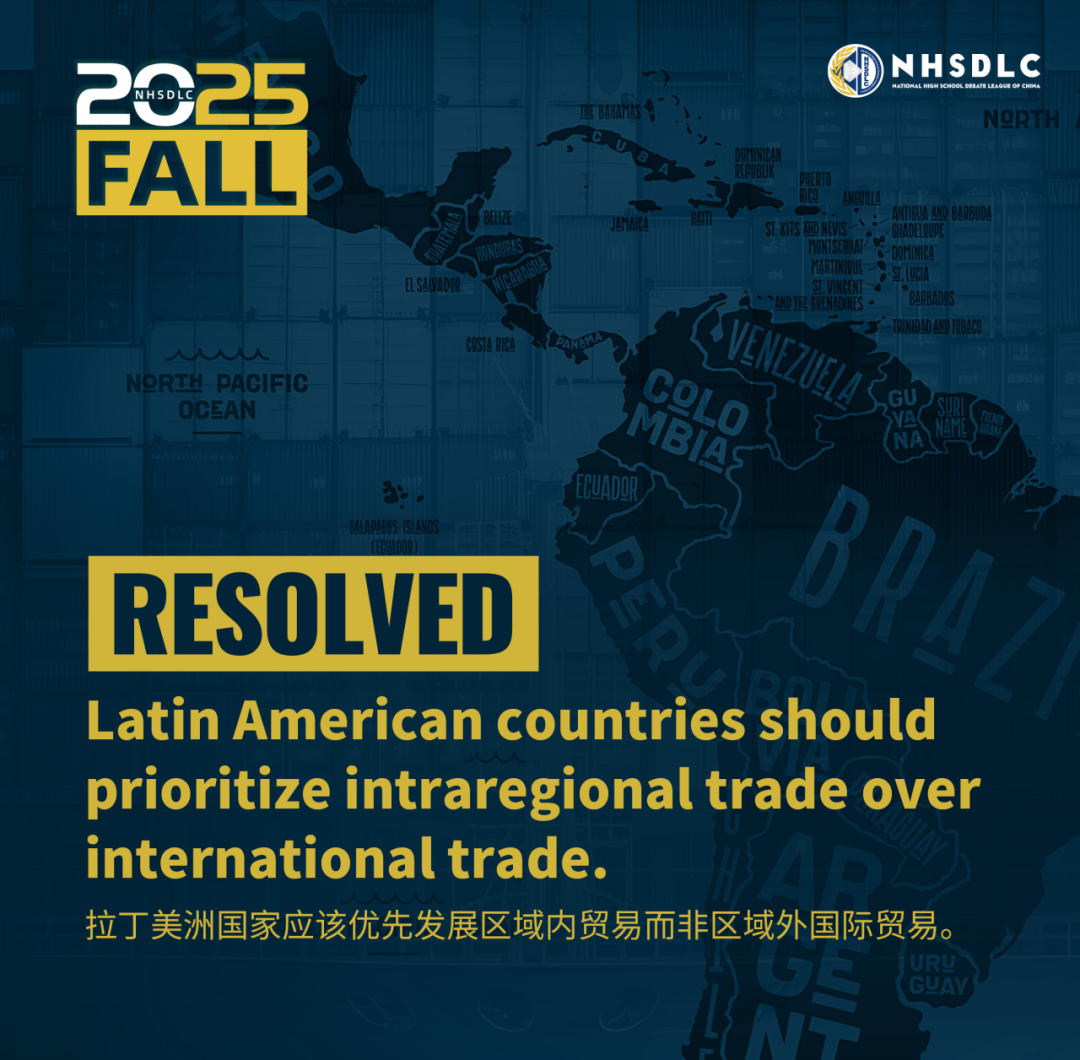
This Fall debaters tackle a pressing economic question, should Latin America focus more on trade within the region or continue to pursue international markets. They are compelling cases for both sides of the debate but let’s begin with an examination of the term “Latin America”, some key terms, then take a deeper dive into some of the Pro and Con arguments.
Latin America
The term "Latin America" is commonly used to describe a cultural and geographical subset of the Americas that includes countries in South America, Central America, Mexico, and some islands in the Caribbean.
Geographically, Latin America spans
- South America: All countries from Colombia and Venezuela southward to Chile and Argentina.
- Central America: Countries from Guatemala to Panama.
- Mexico: Located in the southern part of North America.
- Caribbean: Islands where Spanish, Portuguese, or French are spoken, such as Cuba, the Dominican Republic, and Haiti.
Latin America is characterized by its shared colonial history, language, and many cultural aspects. The Spanish and Portuguese empires colonized vast regions of the Americas from the late 15th through the 18th centuries, which led to the predominance of Spanish and Portuguese languages. French is also spoken in parts of the Caribbean and in French Guiana, a department of France in South America.
The region has a diverse range of economic activities, but many countries in Latin America share similar economic challenges, including inequality, poverty, and political instability. Despite these challenges, the region is rich in culture, history, and natural resources, which play significant roles in the global economy.
Intraregional Trade
Intraregional trade refers to the exchange of goods, services, and capital among countries within the same geographical region.
This type of trade is focused on strengthening economic ties between neighboring countries or within a specific bloc, such as the European Union, ASEAN, or in our case Latin America. The main goal of intraregional trade is to enhance economic integration, stability, and interdependence among the countries in the same region. It often involves agreements that reduce trade barriers like tariffs and quotas, making it easier and more beneficial for countries to trade with their neighbors rather than with distant partners.
International Trade
International trade, on the other hand, involves the exchange of goods, services, and capital across international borders, encompassing a global scale
This type of trade is not restricted to specific regions but occurs between countries worldwide. International trade is driven by the comparative advantages of nations, where countries export goods and services that they can produce more efficiently and import those in which they are less efficient.
International trade is a fundamental component of globalization, acting as both a cause and effect of the increasingly interconnected global economy. The relationship between international trade and globalization is multifaceted, involving economic, technological, political, and cultural dimensions.
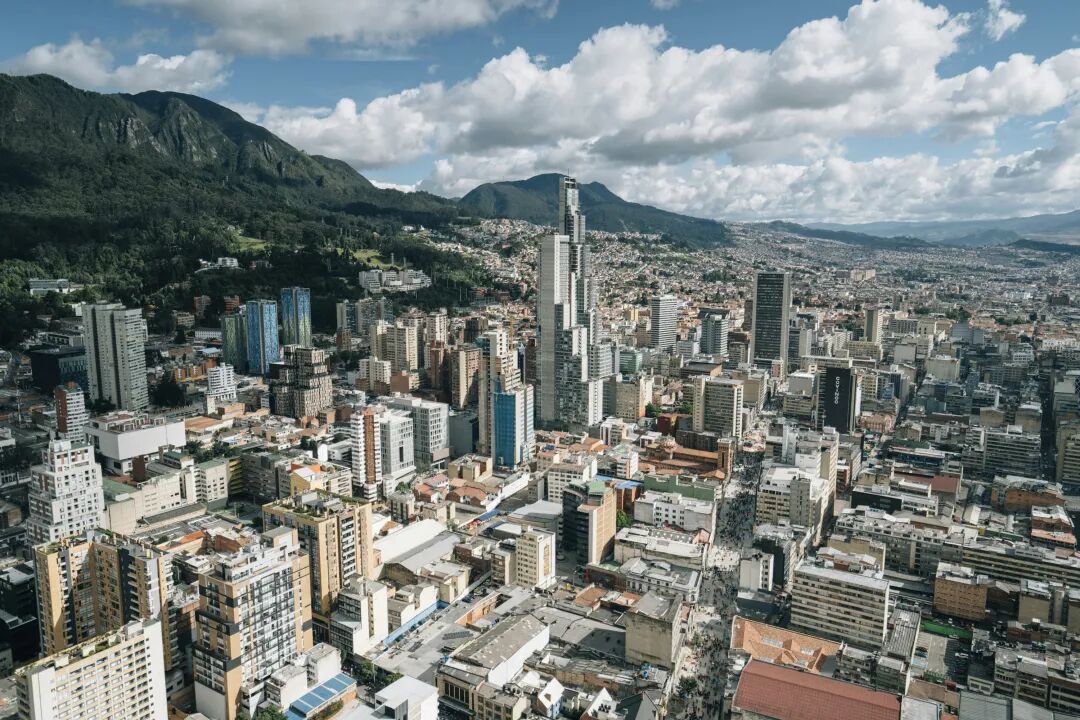
The Case for Prioritizing
Intraregional Trade
Proponents argue that Latin American countries have much to gain by deepening trade relationships with their neighbors in the region. Some key points in favor of an intraregional focus:
Intraregional trade has more economic value for Latin America;Studies show that intra-Latin American exports are more intensive in technology and manufactured goods compared to the region's exports to the rest of the world, which skew towards primary commodities. Expanding this value-added intraregional trade could provide a bigger boost to Latin American economies.
Strengthening regional trade could produce even more economic value;The 33 preferential trade agreements (PTAs) that exist in Latin America and the Caribbean have increased intraregional trade by an average of 64% since their inception. However, these gains fall short of the potential of a $5 trillion integrated regional market. The complex patchwork of separate agreements limits the ability to make the region more competitive internationally. Blending the 33 separate agreements into a single Latin American and Caribbean Free Trade Agreement (LAC-FTA) could add an additional $11 billion in annual intraregional trade flows. An LAC-FTA would boost intraregional trade in all goods by an average of 3.5% or $11.3 billion per year. Mexico in particular could see its intraregional exports expand by 8%, driven mostly by manufacturing. The two largest economies, Brazil and Argentina, are linked to each other but not to Mexico. Those three economies account for almost two-thirds of regional GDP but contribute just 7% to intraregional trade, highlighting a key missing link. The complex web of rules of origin that accompany the 33 PTAs act like a 15% import tariff, making it difficult for firms to source from the most efficient producers and join competitive regional supply chains.
Specific sectors. Some specific sectors beyond agriculture in South America that could potentially benefit from a Latin American regional free trade agreement (FTA) include:
Manufacturing; A FTA could help boost intraregional trade in manufacturing, particularly for Mexico whose manufacturing exports to the region are projected to expand by around 8%, driven by sectors like automotive manufacturing.
Services; Services trade could also benefit from deeper regional integration facilitated by the FTA. This could open up opportunities in sectors like finance, telecommunications, transportation etc.
Extractive industries (mining, energy); With its vast resources of critical minerals like lithium, copper and fossil fuels, the search results suggest Latin American countries rich in these commodities could benefit from increased regional and global demand as a result of the trade agreement Industrial product. One of the search results states that certain industrial products beyond just agriculture and mining could see trade expansion from a regional FTA, though it does not specify which exact industries.
Digital trade/e-commerce; The potential for boosting digital trade flows and e-commerce within an integrated Latin American market could provide opportunities in technology and digital services.
The region is getting pushed out of global export markets. Latin America's share of global manufactured exports peaked in 2001 and has stagnated since, as the region loses ground to other emerging economies. Refocusing on regional integration provides an alternative path for trade-driven growth.
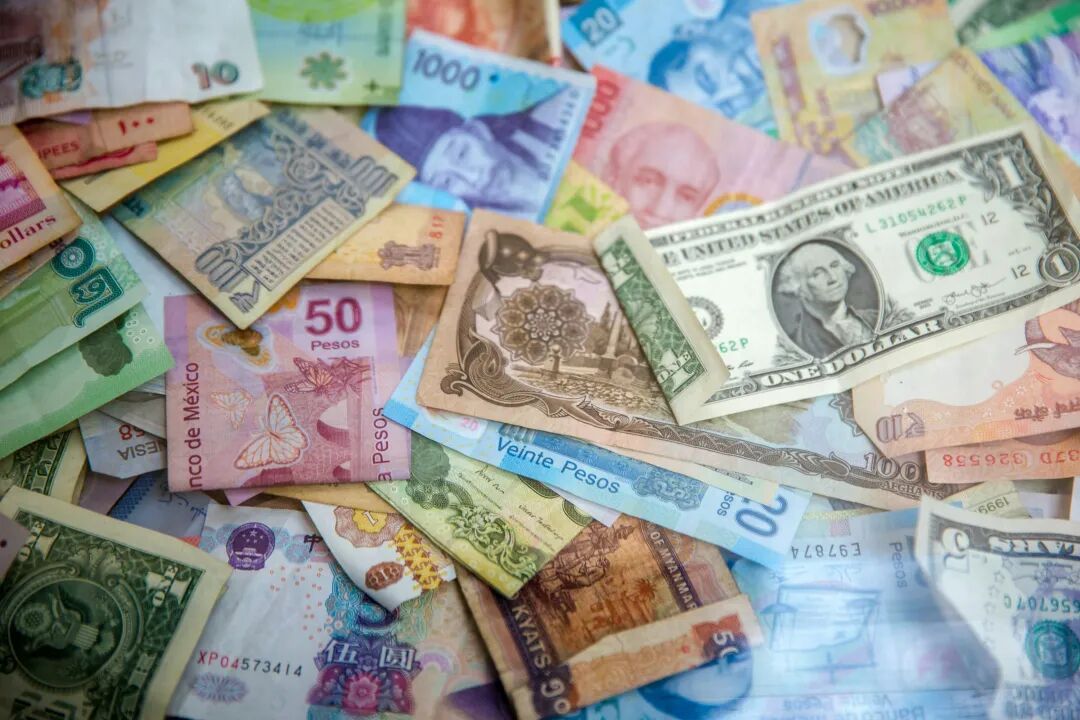
Global trade is becoming less reliable;Supply chain disruptions, geopolitical tensions, and the US-China rivalry are undermining international trade. Regionalization offers Latin America more security and control over trade flows.
Regional trade is greener;Shorter intraregional supply chains mean less carbon-intensive transportation compared to global trade. With Latin America's wealth of critical minerals, it can also drive clean energy production through regional value chains.
Dependence on trade with the U.S. and China is bad;Latin American countries' heavy trade dependence on the United States and China carries substantial economic risks. Relying disproportionately on exports to the massive U.S. and Chinese market leaves these nations extremely vulnerable to economic downturns, protectionist policies, or domestic political shifts. A slump in U.S. demand or increased trade barriers could decimate Latin American export revenues, manufacturing output, employment, and overall economic growth. This lack of diversification prevents Latin American economies from being able to pivot and seek alternative markets if said economic shocks happen.
Successful intraregional trade initiatives and agreements in Latin America:
The Pacific Alliance - Formed in 2011, the Pacific Alliance is an economic bloc consisting of Chile, Colombia, Mexico and Peru.It has successfully reduced tariffs on over 92% of goods traded between members and has integrated their stock markets. Trade between Pacific Alliance members has grown significantly.
Mercosur - Established in 1991, Mercosur is a customs union between Argentina, Brazil, Paraguay and Uruguay.It has eliminated tariffs on most goods traded between members and has facilitated greater economic integration. Intra-Mercosur trade increased substantially in the years after its formation.
Central America-4 (CA-4) Border Control Agreement - Signed in 2006 between El Salvador, Guatemala, Honduras and Nicaragua, the CA-4 allows free movement of citizens and merchandise across their borders.It has reduced border crossing times and costs for regional trade.
Latin American Integration Association (ALADI) - Founded in 1980, ALADI aims to gradually establish a Latin American common market through regional tariff preferences and trade agreements. It has 13-member countries and has promoted growth in intra-regional trade.
Andean Community (CAN)- The Andean Community customs union between Bolivia, Colombia, Ecuador and Peru has liberalized trade and established common external tariffs. Intra-CAN trade grew significantly after its relaunch in the 1990s.
Caribbean Community (CARICOM) Single Market and Economy (CSME)- Implemented in 2006, the CSME facilitates free movement of goods, services, capital and labor between 12 Caribbean nations. It has helped spur increases in intra-regional trade and investment.
The Case for Maintaining
an International Focus
On the other hand, skeptics caution that Latin America cannot afford to turn inward and disengage from the wider global economy. They make the following counterarguments:
Access to major markets is still vital;While promoting greater trade integration and economic interdependence within Latin America itself can help mitigate risks of overreliance on any single partner, access to major global markets remains vital for the region to achieve economies of scale and maximize economic growth potential. Domestic and regional markets in Latin America are still relatively small in size and purchasing power compared to massive consumer markets in the United States, Europe, and Asia. Robust export flows to these huge external demand centers are necessary for Latin American industries to ramp up production levels, benefit from economies of scale, earn valuable foreign exchange, and compete effectively on pricing. Regional demand alone is insufficient to fully utilize Latin America's production capacities across sectors like agriculture, mining, manufacturing, and services. Therefore, Latin American countries need to carefully balance expanding intraregional trade with maintaining strong, diversified export ties to key overseas markets in order to fully leverage competitive advantages and drive long-term sustainable economic development.
Globalization has boosted Latin American economies;The region has made real, if uneven, economic and social progress in the era of globalization since the 1990s. Reversing course now would sacrifice those gains. Globalization and greater integration into world markets has been a major driving force behind economic and social progress across Latin America since the 1990s. By opening up to international trade and investment, the region's economies have been able to leverage their comparative advantages in sectors like agriculture, mining, energy, and manufacturing exports. This expansion of export markets provided new growth engines, employment opportunities, and revenue streams to fund social programs and poverty reduction initiatives. While the benefits have been uneven between and within countries, globalization undeniably helped lift tens of millions of Latin Americans out of poverty and into a rapidly expanding middle class.
However, any moves now to abruptly reverse this integration and retreat from global markets would likely sacrifice these hard-won economic gains. Turning inward and reinstating protectionist policies could cripple Latin America's export sectors, eliminate cross-border investment, and cut off vital flows of trade revenues, foreign exchange, and growth capital. Social progress made possible by globalization could rapidly unravel without those economic drivers. Rather than rejecting globalization wholesale, the priority should be engaging in a smarter, more managed integration that maximizes the benefits while mitigating risks - not risking a return to the cycles of economic stagnation, debt crises, and inequality that plagued the region before embracing global markets.
Specifically, access to US markets has boosted Latin America’s economies. the U.S. remains a vital trade and investment partner for Latin America: "Latin America already has outsize access to the U.S. consumer economy. The United States is the region's largest trading partner, with more than $1.1 trillion in goods and services exchanged each year. It is also Latin America's biggest outside investor, contributing nearly 40 percent of all the foreign direct investment the region receives." "While the region's rate of economic growth in the 1990s was much better than that in the prior decade, it was not enough to have any significant impact on the region's huge unmet social needs. In the last 10 years, per capita income grew by a meager 1.4 percent." This suggests trade with the U.S. contributed to improved, albeit still insufficient, growth in Latin America in the 1990s compared to the previous decade.
Foreign investment requires global trade;Foreign direct investment (FDI) plays a pivotal role in driving economic growth and development in Latin America, particularly in the manufacturing sector. Global firms seek locations with unfettered access to world markets when deciding where to site their production facilities and operations. Any hints of rising protectionism or a retreat from open trade policies in Latin American countries would raise red flags for these potential investors. For example, Mexico has attracted massive manufacturing FDI inflows from automakers, aerospace companies, and electronics firms due to its tight economic integration with the U.S. and Canada through free trade agreements. However, threats to unravel those trade ties would jeopardize future investment. Beyond just tariff concerns, multinational manufacturers are also wary of non-tariff barriers and regulatory hurdles that could disrupt their global supply chains. They need assured access to import raw materials, components, and capital equipment from worldwide sources without excessive constraints. Brazil's efforts to develop a domestic automotive industry through heavy protectionism ultimately stifled competition and technological development in that sector. In contrast, regional integration through Mercosur customs union protocols helped auto plants in Argentina and Brazil integrate into globalized production networks. The apparel and textile industry also highlight Latin America's need for open trade regimes. Many East Asian apparel makers have invested in locations like Guatemala, Honduras, Nicaragua, and the Dominican Republic due to preferential trade agreements giving their output duty-free access into the massive U.S. market. However, any backtracking on those market access commitments would quickly incentivize footloose firms to shift production elsewhere with better global trade facilitation. To attract quality FDI today, Latin American nations must demonstrate stable, commitments to an open, rules-based international trade architecture.
Consumers benefit from global trade;An open trading system facilitates import competition that prevents domestic producers from raising prices excessively, while also giving Latin American consumers access to a vast array of global product variety. By plugging into global value chains, Latin American industries can import high-quality inputs and capital goods from the most efficient international suppliers at competitive prices. This import discipline and access to worldwide sources of supply translates into greater affordability and product choice for the region's rapidly-expanding middle class. In contrast, excessive trade protectionism or exclusively regional economic blocs could allow oligopolistic domestic producers to charge higher markups. Import barriers would reduce competitive pressures and limit product diversity to only what regional partners can supply. This would squeeze real incomes and purchasing power, frustrating consumption-driven growth that has fueled the rise of Latin America's middle class in recent decades. Rather than overpaying for more limited goods, open global trade channels maximize value for these consumers.
The region remains divided;Despite geographic proximity, there are significant political and economic divergences between Latin American nations that complicate efforts to deepen regional economic integration. The struggles and paralysis of trade blocs like Mercosur highlight these challenges, with members bickering over issues like trade policy, protectionist measures, and resistance to ceding sovereignty. More recently, the war in Ukraine has exposed fissures, with countries like Brazil and Mexico taking sharply differing stances over Russia's invasion. Such geopolitical fault lines make it difficult to find consensus on regional priorities and policies. These inherent centrifugal forces of fragmentation within Latin America itself argue for maintaining an outward, international economic orientation. Rather than attempting to reconcile the diverse domestic interests, an externally-focused development model centered on integration with major world markets and value chains can unite the region's economies without getting bogged down in political tensions and nationalistic economic policies that stymie regional cooperation.
Reference:
- Berg, G., & L. C. T. R. (2019). Connecting the Dots: A Road Map for a Better Integration of Latin America and the Caribbean. Inter-American Development Bank. https://publications.iadb.org/en/connecting-dots-road-map-better-integration-latin-america-and-caribbean
- Caribbean Community (CARICOM). (2001). The Revised Treaty of Chaguaramas Establishing the Caribbean Community, Including the CARICOM Single Market and Economy. https://caricom.org/documents/4906-revised_treaty-text.pdf
- Mercosur. (1991). Treaty of Asunción. http://www.sice.oas.org/trade/mrcsr/treatyasun_e.asp
- The Pacific Alliance. (2011). Framework Agreement of the Pacific Alliance.
- https://pacificallianceblog.com/wp-content/uploads/2018/01/2017-Baker-McKenzie-Handbook-Pacific-Alliance-Framework.pdf
- Weisbrot, M., Baker, D., & Rosnick, D. (2002). The Scorecard on Globalization: Twenty Years of Diminished Progress. Center for Economic and Policy Research (CEPR). https://cepr.net/publications/the-scorecard-on-globalization-1980-2000-20-years-of-diminished-progress/#:~:text=This%20report%20looks%20at%20economic,with%20the%20period%201960%2D1980.
2025 NHSDLC秋季常规赛
报名通道现已开启!
线下城市赛具体安排及组别将于近期公布
并陆续开放报名
详情请关注公众号后续通知
